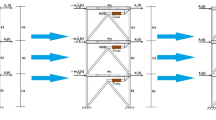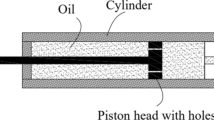Abstract
After nearly a decade of application and investigation, a motion amplification device with viscous dampers for energy dissipation has been recognized as an effective solution to mitigate wind or seismic excitation, especially for stiff structural systems. As a result of compensation of amplified motion, it has been proved that the efficiency of viscous damper largely depends on the motion amplification device configuration, particularly for device stiffness. In this paper, a “scissor-jack” type of motion amplification device, called a “toggle brace damper” system, is studied. It is demonstrated that the efficiency of such a device reflected by its amplification factor is not merely a function of its geometric configuration, but is highly dependent on the support elements’ stiffness as well, similar to the mechanism of a leverage arm. Accordingly, a mathematical model in terms of complex modulus of the viscous damper with consideration of the support brace’s stiffness is established. The results indicate that the efficiency of the motion amplification device with viscous dampers significantly depends on the stiffness of the support elements. Other parameters, such as toggle brace configuration and damping values of the viscous damper, are studied and compared. As an application example, numerical analyses are conducted to study the dynamic performance of a 39-story office tower installed with toggle brace dampers constructed on soft soil in a reclaimed area, under a combined effect of the vortex shedding of an adjacent existing 52-story building and earthquakes. The results show that viscous dampers with a motion amplification system using a properly designed toggle brace device proved to be an effective solution to alleviate the external excitations.
Similar content being viewed by others
References
Berton S and Bolander EB (2005), “Amplification System for Supplemental Damping Devices in Seismic Applications,” J. Struct. Engrg, ASCE, 131(6): 979–983.
Costantinou MC, Tsopelas P, Hammel W and Sigaher A (2001), “Toggle-brace-damper Seismic Energy Dissipation Systems,” J. Struct. Engrg., ASCE, 127(2):105–112.
DeSimone S and Bongiorno S (2002), “The Seismic Solution,” Modern Steel Construction, December.
Hanson RD and Soong TT (2001), Seismic Design with Supplemental Energy Dissipation Devices, EERI Monograph Series, MNO-8, Page 47–53.
Huang C (2004), “Parametric Study for Motion Amplification Devices with Viscous Dampers,” 13th World Conference on Earthquake Engineering, Paper No. 3060, Vancouver, Canada, August 1, 2004.
Huang C and McNamara R (2006), “The Efficiency of the Motion Amplification Device with Viscous Damper,” 8th National Conference for Earthquake Engineering, Paper No. 62, San Francisco, CA, April, 2006.
Hwang JS, Huang YN and Hung YH (2005), “Analytical and Experimental Study of Toggle-brace-damper Systems,” J. Struct. Engrg, ASCE, 131(7): 1035–1043.
McNamara RJ and Huang C (2000), “A Efficient Damper System for High Rise Building,” Fifth Conference on Tall Building in Seismic Regions, Los Angeles, CA, May 5, 2000.
McNamara RJ, Huang C and Wan V (2000), “Viscous Damper with Motion Amplification Device for High Rise Building Applications,” Advanced Technology in Structural Engineering, ASCE Structures Congress 2000, Philadelphia, PA, May 8–10, 2000.
Shao D and Miyamoto K (2002), “Seismic Performance Improvement of a Torsional Irregular Concrete Shear Wall Building Using Toggle-brace-dampers,” Proceeding of Seminar on Response Modification Technologies for Performance Based Seismic Design, ATC-17-2, Los Angeles, CA, 2002.
Author information
Authors and Affiliations
Corresponding author
Rights and permissions
About this article
Cite this article
Huang, H.C. Efficiency of the motion amplification device with viscous dampers and its application in high-rise buildings. Earthq. Eng. Eng. Vib. 8, 521–536 (2009). https://doi.org/10.1007/s11803-009-9116-2
Received:
Accepted:
Published:
Issue Date:
DOI: https://doi.org/10.1007/s11803-009-9116-2




